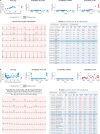Artificial intelligence-enhanced electrocardiography in cardiovascular disease management
- PMID: 33526938
- PMCID: PMC7848866
- DOI: 10.1038/s41569-020-00503-2
Artificial intelligence-enhanced electrocardiography in cardiovascular disease management
Abstract
The application of artificial intelligence (AI) to the electrocardiogram (ECG), a ubiquitous and standardized test, is an example of the ongoing transformative effect of AI on cardiovascular medicine. Although the ECG has long offered valuable insights into cardiac and non-cardiac health and disease, its interpretation requires considerable human expertise. Advanced AI methods, such as deep-learning convolutional neural networks, have enabled rapid, human-like interpretation of the ECG, while signals and patterns largely unrecognizable to human interpreters can be detected by multilayer AI networks with precision, making the ECG a powerful, non-invasive biomarker. Large sets of digital ECGs linked to rich clinical data have been used to develop AI models for the detection of left ventricular dysfunction, silent (previously undocumented and asymptomatic) atrial fibrillation and hypertrophic cardiomyopathy, as well as the determination of a person's age, sex and race, among other phenotypes. The clinical and population-level implications of AI-based ECG phenotyping continue to emerge, particularly with the rapid rise in the availability of mobile and wearable ECG technologies. In this Review, we summarize the current and future state of the AI-enhanced ECG in the detection of cardiovascular disease in at-risk populations, discuss its implications for clinical decision-making in patients with cardiovascular disease and critically appraise potential limitations and unknowns.
Conflict of interest statement
P.A.N., Z.I.A., P.A.F. and the Mayo Clinic have filed patents on several AI–ECG algorithms and could receive financial benefit from the use of this technology. At no point will P.A.N., Z.I.A., P.A.F. or the Mayo Clinic benefit financially from its use for the care of patients at the Mayo Clinic.
Figures




References
-
- Krizhevsky A, Sustskever I, Hinton GE. ImageNet classification with deep convolutional neural networks. Adv. Neural Inf. Process. Syst. 2012;25:1106–1114.
Publication types
MeSH terms
LinkOut - more resources
Full Text Sources
Other Literature Sources

